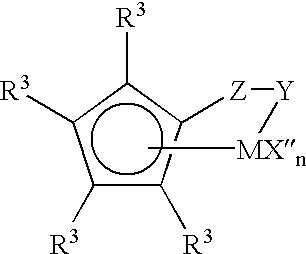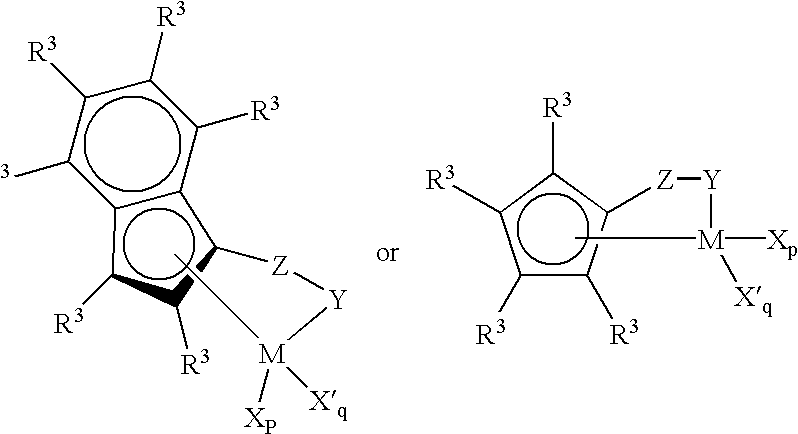High density ethylene homopolymers and blend compositions
a technology of ethylene homopolymer and ethylene homopolymer, which is applied in the direction of metallocenes, organic chemistry, chemistry apparatus and processes, etc., can solve the problems of affecting the bulk density of the polymer will decrease below acceptable levels, and the reaction reaction may fail to meet the requirements of the reactor, so as to improve the appearance of the film, increase the formation of tie molecules, and improve the effect of toughness and impact strength
- Summary
- Abstract
- Description
- Claims
- Application Information
AI Technical Summary
Benefits of technology
Problems solved by technology
Method used
Image
Examples
example 1
Catalyst Preparation
[0453]The supported cocatalyst was a silica / methylalumoxane support having the properties of and prepared substantially as described in WO 96 / 16092 (prepared by Witco GmbH, lot No TA 02794 / HL / 30) containing between 23 and 25 weight percent of aluminum. A 100 g sample of the support was slurried for four hours in 800 ml of hexane to which was added an Isopar™ E (Exxon) solution of the constrained geometry catalyst {(tert-butylamido)dimethyl (tetramethyl-η5-cyclopentadienyl)silane}dimethyl-titanium(IV) sufficient to obtain a final catalyst loading of 40 micromole of titanium for one gram of support. The catalyst was transferred to the catalyst feed vessel of the plant. In this vessel, the supported catalyst was further diluted with isopentane to obtain a concentration of 0.5 micromole titanium per ml. This catalyst is abbreviated as “CGC / MAO” in Table 1.
[0454]The polymerization was performed in a continuous slurry process using a single reactor mode. ...
examples 2 – 7
Examples 2–7
[0455]Examples 2–7 were produced in a similar fashion to Example 1, but using the process conditions listed in Table 2.
examples 8 – 14
Examples 8–14
Catalyst Preparation.
[0456]The catalyst used was the combination of a silica-supported borate activator and a constrained geometry prepared essentially as described in WO 96 / 28480, Example 28. This catalyst was given the abbreviation of “CGC / Borate” in Table 1.
[0457]Examples 8–14 were produced in a similar fashion as Example 1, but using the process conditions listed in Table 2.
Comparative Experiments A–C
Catalyst Preparation
[0458]The comparative experiments A–C were produced, using the Ziegler-Natta supported catalyst as described in U.S. Pat. No. 4,661,465 (abbreviated as “Ziegler” in Table 3).
[0459]The polymerization was performed in a continuous slurry process using a single reactor mode similar to that described for Example 1.
Comparative Experiments D–F
[0460]The comparative experiments D–F were produced as for Comparative Experiments A–C but in a commercial size slurry production facility, the process conditions of which are listed in T...
PUM
| Property | Measurement | Unit |
|---|---|---|
| temperature | aaaaa | aaaaa |
| temperature | aaaaa | aaaaa |
| temperatures | aaaaa | aaaaa |
Abstract
Description
Claims
Application Information
 Login to View More
Login to View More - R&D
- Intellectual Property
- Life Sciences
- Materials
- Tech Scout
- Unparalleled Data Quality
- Higher Quality Content
- 60% Fewer Hallucinations
Browse by: Latest US Patents, China's latest patents, Technical Efficacy Thesaurus, Application Domain, Technology Topic, Popular Technical Reports.
© 2025 PatSnap. All rights reserved.Legal|Privacy policy|Modern Slavery Act Transparency Statement|Sitemap|About US| Contact US: help@patsnap.com



